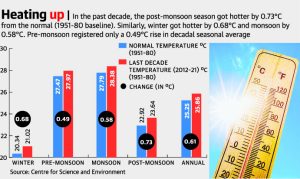08 Jul 2022 Impact of Global Warming on Indian Monsoon
Impact of Global Warming on Indian Monsoon – Today Current Affairs
Context:
It has been observed that during the monsoon seasons the temperatures are 0.3 degrees Celsius higher than the average summer figures’ which explains some anomalies in the climate change
Today Current Affairs
Introduction
Recently, it has been reported that the temperature during the monsoon season is higher in comparison to the summer season however it should be lesser. Generally, the Mansoon season gives us relief from the higher temperature but this year one side high temperature distraught the people, and on the other side high humidity also.

Data of Higher Temperature in India – Today Current Affairs
- If we see the date of the average temperature of all India levels, we see the average temperature is 0.3 degrees Celsius higher than the average summer temperatures (March to May). If we compare it from 1951 to 1980 we see it has risen in comparison to past years. In the past decade, 2012-2021, this anomaly has risen to 0.4 degrees Celsius.
- As per the data record of the India Meteorological Department, the average temperature of India has risen 0.62 degrees Celsius from 1901 to 2020. The Centre for Science and Environment (CSE) (A nonprofit organization of research-based in Delhi ) shows it has translated to summer temperatures rising slower than not only monsoon but even post-monsoon (October-December) and winter (January and February) temperatures. The Hindu Analysis
- However, the rise in temperature can be also observed in the summer season. In the summer season, it has risen up to .49 degrees Celsius while in summer it rose .58 degrees celsius. This year, India saw record pre-monsoon temperatures in northern and western regions, in the absence of rain.
- The average daily temperature has also risen mainly in Northern India. The average daily maximum temperature for March and April for Chandigarh, Delhi, Haryana, Himachal Pradesh, Jammu & Kashmir, Ladakh, Punjab, Rajasthan, Uttar Pradesh, and Uttarakhand — as per IMD classification — was almost 4 degrees Celsius above normal (compared to its baseline of 1981-2010), which is just double as the anomaly observed at all India level
Causes of these Temperature anomalies : The Hindu Analysis
As per the report of the Institute of Climate Change Studies(An autonomous body under the state government of Kerala ), the temperature anomalies are increasing mainly because of less clouding on a higher number of days. “So, if rainy days are reducing, cloudless or less cloudy days will increase.
The causes of the rise in temperature can also be linked to the Global warming
Pollution is another reason for the higher temperature of the cities. A city also generates a lot of waste heat due to human activities which adds to the natural heat. This extra heat should dissipate after sunset, but due to pollution and continuing generation of waste heat the city fails to cool down, leading to the warmer conditions compared to rural areas,”
Consequences : The Hindu Analysis
Because of the high temperature, many deaths have been recorded due to lu and heart attack, dehydration, etc. The Increased temperature and humidity impact the efficiency of the work. The headache and tiredness are the other impacts of the high temperature.
Today Current Affairs
Conclusion
As per the above analysis, it has been observed that due to pollution and Global warming how our daily life is being impacted. Therefore all of us should have civic sense and should try to reduce the pollution from our side. Because , pollution and climate change are the inevitable consequences of urbanization. therefore, we should opt for several measures to reduce the inevitable consequences of urbanization otherwise we have to pay the big cost of this climate change
In this article we mention all information about Impact of Global Warming on Indian Monsoon Today Current Affairs.
Source: The Hindu, Hindustan Times
GS papers I and III


No Comments